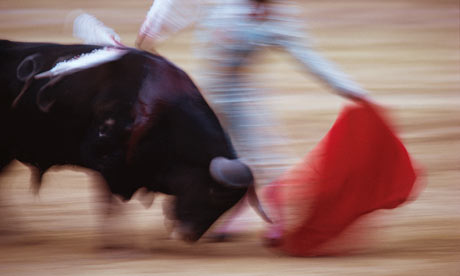
The danger inherent in bullfighting and extreme sports is often what makes them so compelling to take part in – and watch. Photograph: Hidemi Kanezuka/Getty Images
Animal rights issues surrounding bullfighting aside, the nature of Aparicio's injuries not only serves to remind us how brutal this activity can be for the men and women involved, but also questions the motivation behind such dangerous activities – whether they be considered a sport, an art form, or simply an attention-grabbing venture in which people willingly place their lives in jeopardy.
We are well accustomed to reading headlines about daredevil stunts by the likes of Evel Knievel, as well as exploratory adventures, which are done as much as for the thrill as for the final outcome. Everest is a classic example of this: on Saturday, 13-year-old Jordan Romero became the youngest person ever to reach the summit of Mount Everest. The previous week 22-year-old Bonita Norris became the youngest British woman to reach the summit. In spite of tremendous risks posed to life and limbs, ego is the clear motive behind such endeavours. Mastering such a huge feat, at any age, is in itself a great achievement. The knowledge that they would also be making history along the way must only have helped spur them on.
However, not everyone does it to be a record breaker. Sixteen-year-old Jessica Watson recently sailed around the world unaided, knowing from the very start that the World Speed Sailing Record Council would not officially recognise her voyage after discontinuing its youngest category in 1999 over fears for people's safety. Record or no record, for these intrepid young people, the high risks posed to their health and safety seem a small price to pay for the opportunity to realise their dreams.
In a similar way to bullfighting, a number of people have built careers around doing death-defying stunts. American illusionist David Blaine and French high-wire artist Philippe Petit are two such examples of stuntmen who blend high risk with artistry to create unique spectacles. Some have gone even further for their art. In December 2009, epileptic Portuguese performance artist Rita Marcalo provoked widespread concern for her safety when she announced the intention to self-induce a seizure on stage. Marcalo's extreme decision to give up anticonvulsant medication to facilitate the project – which received £13,889 funding from the Arts Council of England and a further £7,000 commission – was motivated by her desire to raise greater awareness about epilepsy. Despite ultimately failing to induce a seizure during Involuntary Dances at the Bradford playhouse, Marcalo's daring deed attracted crowds of people and did enough to champion her cause.
Aparicio may not have scaled Everest or sailed around the world solo, but every time he or another matador enters the bullring, they put their lives on the line. When I went to see a bullfight while living in Madrid, more out of curiosity than any morbid desire to see live bloodshed, I flinched every time a bull was gored. But the risk posed to the matadors themselves was arguably even more unnerving.
Although I do not condone the violence of this sport, there is no doubting that it is the very element of danger itself which has turned bullfighting into an artistic spectacle. Its cultural origins have always made it much more than just another extreme sport – it has become both a ritual and a vocation. It may not promote a cause (some would say quite the opposite) or break world records, but the profession gets as close as you can get to dying for your art.
As Aparicio lies in his hospital bed recovering, it is hard to think of anyone who has got much closer.
No comments:
Post a Comment